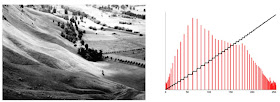Many types of image processing can be classified into some categories:
- Pixel operation is an operation of pixels that each pixel in an image is operated independently, means that the value of the pixel is not affected by other pixels value. It depends solely on its previous value and the operation parameters. Brightness and contrast manipulation are the examples.
- Global operation, when a global characteristic of an image is used to deduct the parameter to operate each pixel. The global characteristic is usually determined using statistical method, for example is automatic brightness and contrast equalization, where the histogram is redistributed for a better distribution.
- Multi-frame operation, where an image is operated with other images to get a result. For example is the generation of transitional image of subsequent slow motion picture. When a 20 fps (frames per second) movie will be played back four times slower, it looks smoother if we show them in 20 fps with 3 additional transition frames between the two original frames, rather than show only the original frames by 5 fps.
- Geometric operation, where the shape, size, or the orientation is modified. Resizing and skewing are some examples.
- Neighboring pixels operation, where the result of a pixel operation depends not only on its previous value but also on other surrounding pixels values. Smoothing and sharpening operation are some examples.
- Morphologic operation, is operation that is focused on specific image region. This operation is closely related to image analysis, because it deals with object/morph detection algorithm.
There are many program software used for image processing, and Delphi is one of them. Delphi doesn't provide image processing component, but uses processing algorithm. To learn image processing in Delphi by directly coding the algorithm, GUI (graphical user interface) is made to load an image, view, process, and show the result.
Image histogram (gray level histogram) is one of simple and easy statistical tool for image analysis. From the histogram, many useful information of an image can be represented from an image. Image histogram is easy and fast to compute. Gray level histogram is a function that shows how many pixels for every gray level exist in an image. The x-axis is the gray level, and the y-axis is the numbers of pixels that have certain level appear on an image.
Above figure shows an image and its histogram. The histogram shows that the pixels values (the gray level values) is distributed only on the middle part of the available level, at levels from 100-200. It is said that the image doesn't maximize the usage of the available bit-depth (0-255). Using image processing techniques, the image can be manipulated to equalize the histogram, to have a better picture.
Image histogram analysis is very useful in image processing, some of the purposes are:
- Selecting appropriate digitizing parameter. Histogram can be used to visually judge if an image is in an appropriate range of gray level. Ideally, digital image should use all available gray scale range, from minimum to maximum. This is important to optimize the display and other imaging devices to use all their potential capability. The imaging devices will be optimum if they display (or print) the image data that contain optimum usage of its format (for example 0-255 for 8bit monochrome image).
- Selection of Thresholding Level. One of image processing technique is thresholding, where all pixels above certain brightness level are maximized to the maximum value and others are minimized to the minimum value. Thresholding in image processing is used to convert a gray scale image to binary format, where only two values are possible for the pixel, zero or one. Thresholding can be viewed as the simplest method of image segmentation.
Thresholding is common step in an image analysis, where we need to differentiate the pixel area by two different brightness areas, for example between object and the background. This is very useful in object and background separation if there is significant difference between an object and its background on an image.





No comments:
Post a Comment